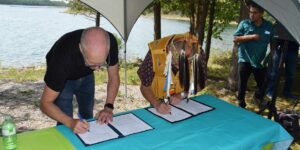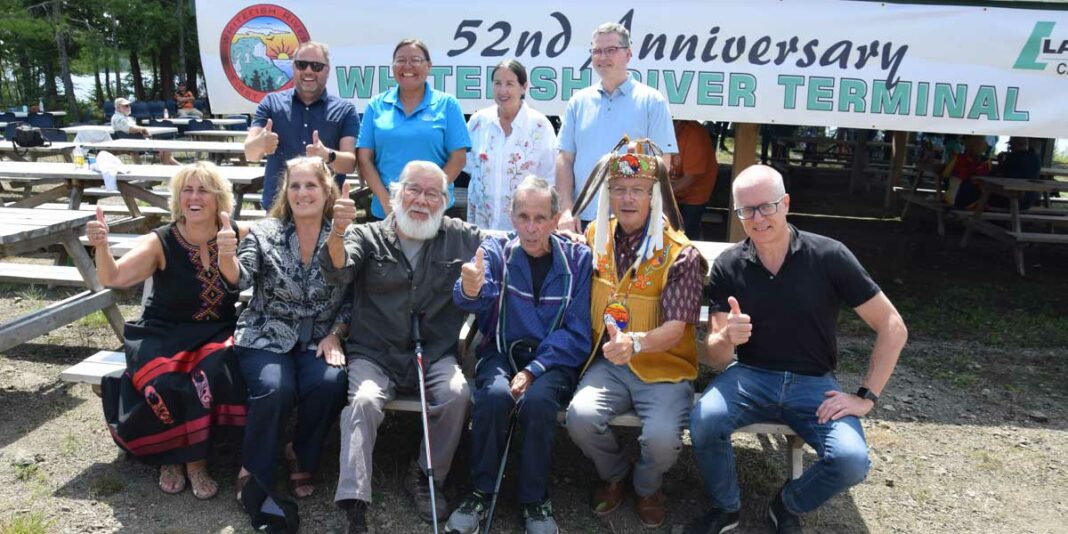WHITEFISH RIVER FN—The Lafarge Whitefish River terminal has seen a tremendous amount of activity over the past 52 years and, thanks to the hard work and determination of the negotiators for Whitefish River First Nation and the cement company giant Lafarge, a new 50-year memorandum of agreement (MOU) was signed during the annual Lafarge fish fry.
The gathering feast has been a tradition at the terminal site for many years, and although the pandemic put the celebration on hold for the past three years, the gathering roared back this past Wednesday, August 16. Some 300 community members gathered on the shore beneath the gaze of Dreamer’s Rock on to enjoy music, food, some speeches by gathered dignitaries, prizes and to pay witness to the signing of the historic 50-year agreement by Whitefish River First Nation Ogimaa Rodney Nahwegahbow and Lafarge Eastern District CEO David Redfern.
Ogimaa Nahwegahbow spoke about the important role the MOU has played and will continue to play in the future of the WRFN and thanked the negotiators, Esther Osche and Fr. George Gardner for their efforts.
Mr. Redfern made a land acknowledgment at the beginning of his remarks before going on to note the generational aspect of the MOU and the pride felt by Lafarge in its collaboration with WRFN. “For generations you have been on the land,” he said. “As guests on your land, we are honoured to celebrate with you today.”
Mr. Redfern went on to thank Ogimaa Nahwegahbow, the WRFN councillors, Algoma-Manitoulin-Kapuskasing MP Carol Hughes, “our friends from Fisher Wavy” and the people of WRFN, as well “as the Creator responsible for this fabulous day.”
Mr. Redfern pointed to the 20 representatives from Lafarge who were in attendance as a symbol of the importance of the MOU to the company. He pointed out that, since the original MOU in 1971, Lafarge has shipped five million tons of cement through the plant.

Another great reason for celebration is the fact that, in the 52 years of its operation, the Lafarge terminal has not had a single lost-time accident. “That is a testament to everyone who has worked here,” said Mr. Redfern.
Fr. Gardner, who negotiated the original MOU for the Whitefish River terminal for Lafarge, and is an honourary WRFN chief, was guided to the podium by WRFN negotiator Esther Osche and his research assistant Mary Scannell. Fr. Gardner relayed some of the history behind the original MOU and the challenges he and Ms. Osche faced in securing the environmental safety of Dreamer’s Rock and having it written into the MOU.
Fr. Gardner noted that it took some time and a lot of discussion to bring home the importance of Dreamer’s Rock as a site sacred to the community of WRFN and he lauded the efforts of Ms. Scannell in compiling the research data needed to reinforce the message to those in charge of the environmental assessments.

Fr. Gardner remembered a photo published in The Expositor in 1969 of Esther Osche, Leona Nahwegahbow and Arthur Nahwegabow. “Arthur was the original chief who got this going,” he said, calling on original council members and current members to stand and be recognized.
“Just before we had this event today, Chief Rodney and I talked about how young he was when all this started, and his dad worked here at the terminal, we have all of that to remember,” said Fr. Gardner. “A lot of people have worked at this, a team effort. We had the team of WRFN with us, we had the team of Lafarge, we had the team of some of the folks here today. Esther was part of this last lease; Esther and I go back many, many years. That is part of the loving care between us.” He also thanked Kathleen Migwanabi, WRFN land manager, for her hard work and diligence and Ms. Scannell for her tireless efforts in researching the information needed to protect Dreamer’s Rock.
Following the speeches, a pair of paintings by Anishinaabe artist Mike Cywink were presented, one of which will hang at WRFN and the other at Lafarge to remind both parties of their commitment to each other. The symbolism contained in the paintings included blueberries and strawberries, foods sacred to the Anishinaabe and 50 stars, one for each year of the MOU.
Presentations to the four terminal workers commemorating the 52 years of no lost-time accident were made, prizes drawn for adults and youth and a huge fish fry was enjoyed by all.





